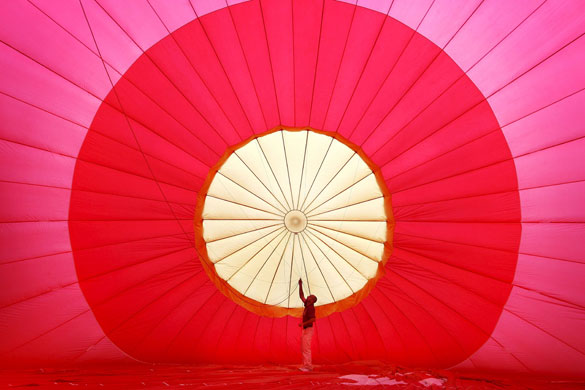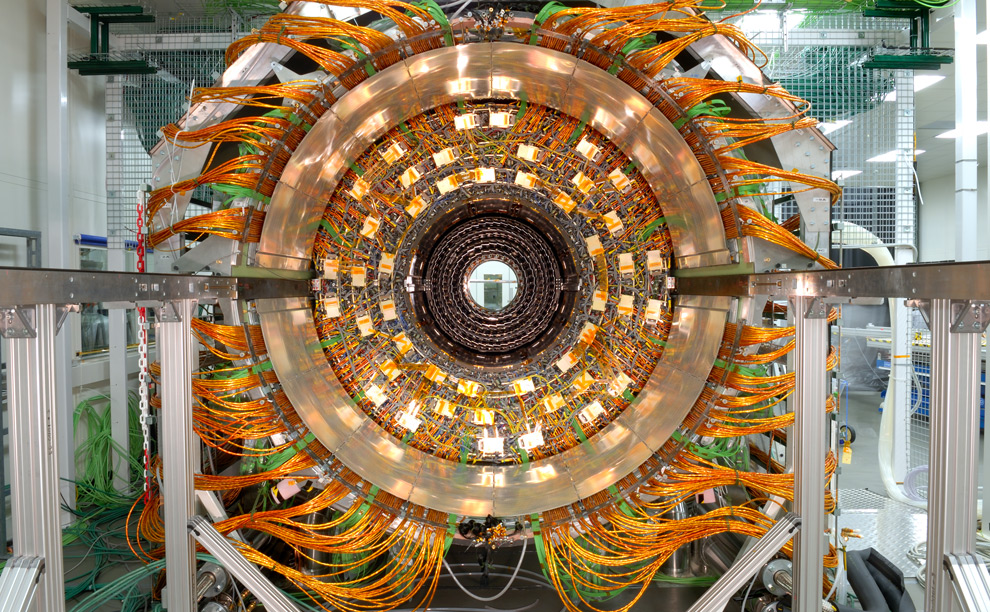Whether traveling or just hanging out at the beach or barbeque, summer is thought of as a time to actually look at the world. You might be watching an ant working at a giant crumb, or boats bobbing in the harbor, or accidental patterns in the crowd at the ball park, but you are looking at something instead of merely scanning as you would when going about your business.
Photography can do the same: not merely record the world but bring one to see it anew, if only because one is looking for more than a few milliseconds and without a specific objective in mind. So it is that we might value the image of a water droplet on a leaf or of ice cream clouds in a blue summer sky. But there is more than one way to open the doors of perception. Like this:

This big, vibrant image is of a hot air balloon being inflated at the 13th European balloon festival at Igualada, Spain. But is it a photograph of a hot air balloon or of a mandala? Both, of course, and for some viewers other analogies may come to mind, say of an enormous Japanese umbrella. Part of seeing slowly is letting one’s imagination come into play. Even so, the mandala struck my mind as surely as the photo struck my eye.
But what kind of mandala is this? It would seem to be an accidental pattern more than a sacred object. Taken from another angle, the balloon would have looked much more deflated or conical or uninteresting, yet here the perfectly symmetrical form is perfectly centered to focus perception. The mandala is created not so much by the balloon but by the photographer.
That said, the photograph does nothing to draw attention to itself. The focus in entirely on the archetypal design. That form is not quite complete but, better yet, emerging smoothly from the ground into its own space. The ascension into an all-encompassing form is marked further by its relation to the figure in the center, who is dwarfed but not harmed by the larger power that he serves.
Come to think of it–and to look again–he could almost double for a priest performing a ritual. Perhaps there is a sacred dimension to this image of cosmological coherence after all? Art and nature are unified in a single design that induces serenity while offering an aperture to the inner light of a transcendent reality. The response to the photograph would be just what could be induced by ritual use of a mandala: a more contemplative state of mind.
Which you might need when looking at this:

This is from a photo-essay at The Big Picture on the Large Hadron Collider (LHC) under consruction by the European Organization for Nuclear Research (CERN). The caption read: “View of the CMS (Compact Muon Solenoid) experiment Tracker Outer Barrel (TOB) in the cleaning room. The CMS is one of two general-purpose LHC experiments designed to explore the physics of the Terascale, the energy region where physicists believe they will find answers to the central questions at the heart of 21st-century particle physics.” True enough, but it’s still a mandala.
I would not say it is a particularly serene mandala, however. The machine looks angry–as if it were some cybernetic monster from a sci-fi flick, its tentacles lashing to and fro, all garish colors of a vital but alien biology, a gaping maw, and somehow I also sense both fire and frenetic ants. If it were a deity, it would be one representing voracious nastiness and other unsanctioned pleasures. But, of course, it is not that, and this is not the place to allude to Frankenstein and moralize about scientific overreaching. Instead, look again, longer, and see the unity of art and nature. Consider how the photographer has created another mandala for you, and other that may be a bit more challenging than some of the others. Or, one that can allow us to think about the not so serene parts of who we are, individually and as a civilization.
Two mandalas, each unique and yet the same, for you to use as much or little as you wish. As if on a summer’s day, with all the time in the world. . . .
Photographs by Susi Saez/EPA and Maximillien Brice/CERN.
These are some great found mandalas. It’s interesting that you would use the word “nature” to describe these images. Do you mean by nature essentially the surrounding material or physical world, in which the mandala manifests without the specific intention of creating it? Maybe the Hadron collider really isn’t such a stretch from a deity.
Luke: By “art” I meant anything the is the result of human design–any intentional construction–with “nature” referring to what happens without need of human intentionality. And we might agree that the Hadron collider may be a step toward deeper understanding of the the unity of art and nature, a untity that is suggested by any mandala.
That’s an interesting way of looking at it, and I think it makes a lot of sense. Certainly we can see that humans occupy a special role on the planet. But since the human species was not made from human intentionality, then human beings it would seem are part of nature, making unnatural objects through a natural process, which then collectively begin to disrupt natural systems. Maybe instead of unity it is tangentiality.